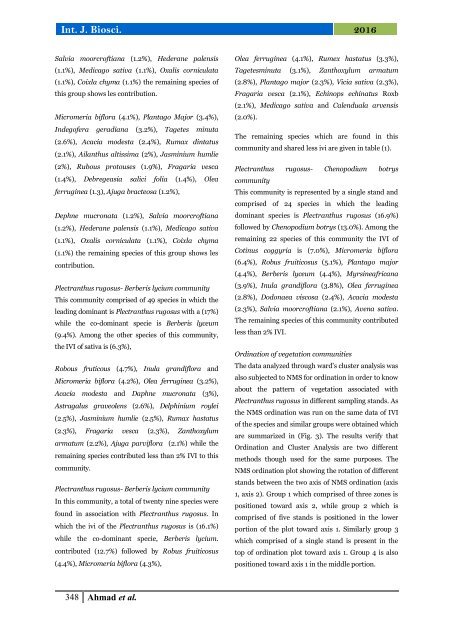Vegetation structure of Plectranthus rugosus dominated communities in Tehsil Kabal district, Swat
The present study aimed to investigate the status of Plectranthus rugosus dominated communities in Kabal swat. Various phytosociological attributes of all the recorded species were obtained. For quantitative analysis of vegetation a 4x4 m2 quadrat was used and a total of ten stands were sampled. Five quadrats were taken randomly per stand. Descriptive information altitude of the sampling site was recorded. For classification and ordination of vegetation data Ward’s Cluster Analysis and Nonmetric Multidimensional Scaling (NMS) ordination was applied using PC-Ord software which results into the formation of four communities groups at 50% remaining information of the species. The highest values IVI, density/ha and cover/ha of Plectranthus rugosus was recorded in communities’ group I while lowest value of ivi, density/ha and cover/ha was recorded in community group 3 which is due to the anthropogenic disturbance as observed during field survey.
The present study aimed to investigate the status of Plectranthus rugosus dominated communities in Kabal swat. Various phytosociological attributes of all the recorded species were obtained. For quantitative analysis of vegetation a 4x4 m2 quadrat was used and a total of ten stands were sampled. Five quadrats were taken randomly per stand. Descriptive information altitude of the sampling site was recorded. For classification and ordination of vegetation data Ward’s Cluster Analysis and Nonmetric Multidimensional Scaling (NMS) ordination was applied using PC-Ord software which results into the formation of four communities groups at 50% remaining information of the species. The highest values IVI, density/ha and cover/ha of Plectranthus rugosus was recorded in communities’ group I while lowest value of ivi, density/ha and cover/ha was recorded in
community group 3 which is due to the anthropogenic disturbance as observed during field survey.
You also want an ePaper? Increase the reach of your titles
YUMPU automatically turns print PDFs into web optimized ePapers that Google loves.
Int. J. Biosci. 2016<br />
Salvia moorcr<strong>of</strong>tiana (1.2%), Hederane palensis<br />
(1.1%), Medicago sativa (1.1%), Oxalis corniculata<br />
(1.1%), Coixla chyma (1.1%) the rema<strong>in</strong><strong>in</strong>g species <strong>of</strong><br />
this group shows les contribution.<br />
Micromeria biflora (4.1%), Plantago Major (3.4%),<br />
Indeg<strong>of</strong>era geradiana (3.2%), Tagetes m<strong>in</strong>uta<br />
(2.6%), Acacia modesta (2.4%), Rumax d<strong>in</strong>tatus<br />
(2.1%), Ailanthus altissima (2%), Jasm<strong>in</strong>ium humlie<br />
(2%), Rubous protouses (1.9%), Fragaria vesca<br />
(1.4%), Debregeasia salici folia (1.4%), Olea<br />
ferrug<strong>in</strong>ea (1.3), Ajuga bracteosa (1.2%),<br />
Dephne mucronata (1.2%), Salvia moorcr<strong>of</strong>tiana<br />
(1.2%), Hederane palensis (1.1%), Medicago sativa<br />
(1.1%), Oxalis corniculata (1.1%), Coixla chyma<br />
(1.1%) the rema<strong>in</strong><strong>in</strong>g species <strong>of</strong> this group shows les<br />
contribution.<br />
<strong>Plectranthus</strong> <strong>rugosus</strong>- Berberis lycium community<br />
This community comprised <strong>of</strong> 49 species <strong>in</strong> which the<br />
lead<strong>in</strong>g dom<strong>in</strong>ant is <strong>Plectranthus</strong> <strong>rugosus</strong> with a (17%)<br />
while the co-dom<strong>in</strong>ant specie is Berberis lyceum<br />
(9.4%). Among the other species <strong>of</strong> this community,<br />
the IVI <strong>of</strong> sativa is (6.3%),<br />
Robous fruticous (4.7%), Inula grandiflora and<br />
Micromeria biflora (4.2%), Olea ferrug<strong>in</strong>ea (3.2%),<br />
Acacia modesta and Daphne mucronata (3%),<br />
Astragalus graveolens (2.6%), Delph<strong>in</strong>ium roylei<br />
(2.5%), Jasm<strong>in</strong>ium humlie (2.5%), Rumax hastatus<br />
(2.3%), Fragaria vesca (2.3%), Zanthoxylum<br />
armatum (2.2%), Ajuga parviflora (2.1%) while the<br />
rema<strong>in</strong><strong>in</strong>g species contributed less than 2% IVI to this<br />
community.<br />
<strong>Plectranthus</strong> <strong>rugosus</strong>- Berberis lycium community<br />
In this community, a total <strong>of</strong> twenty n<strong>in</strong>e species were<br />
found <strong>in</strong> association with <strong>Plectranthus</strong> <strong>rugosus</strong>. In<br />
which the ivi <strong>of</strong> the <strong>Plectranthus</strong> <strong>rugosus</strong> is (16.1%)<br />
while the co-dom<strong>in</strong>ant specie, Berberis lycium.<br />
contributed (12.7%) followed by Robus fruiticosus<br />
(4.4%), Micromeria biflora (4.3%),<br />
Olea ferrug<strong>in</strong>ea (4.1%), Rumex hastatus (3.3%),<br />
Tagetesm<strong>in</strong>uta (3.1%), Zanthoxylum armatum<br />
(2.8%), Plantago major (2.3%), Vicia sativa (2.3%),<br />
Fragaria vesca (2.1%), Ech<strong>in</strong>ops ech<strong>in</strong>atus Roxb<br />
(2.1%), Medicago sativa and Calenduala arvensis<br />
(2.0%).<br />
The rema<strong>in</strong><strong>in</strong>g species which are found <strong>in</strong> this<br />
community and shared less ivi are given <strong>in</strong> table (1).<br />
<strong>Plectranthus</strong> <strong>rugosus</strong>- Chenopodium botrys<br />
community<br />
This community is represented by a s<strong>in</strong>gle stand and<br />
comprised <strong>of</strong> 24 species <strong>in</strong> which the lead<strong>in</strong>g<br />
dom<strong>in</strong>ant species is <strong>Plectranthus</strong> <strong>rugosus</strong> (16.9%)<br />
followed by Chenopodium botrys (13.0%). Among the<br />
rema<strong>in</strong><strong>in</strong>g 22 species <strong>of</strong> this community the IVI <strong>of</strong><br />
Cot<strong>in</strong>us coggyria is (7.0%), Micromeria biflora<br />
(6.4%), Robus fruiticosus (5.1%), Plantago major<br />
(4.4%), Berberis lyceum (4.4%), Myrs<strong>in</strong>eafricana<br />
(3.9%), Inula grandiflora (3.8%), Olea ferrug<strong>in</strong>ea<br />
(2.8%), Dodonaea viscosa (2.4%), Acacia modesta<br />
(2.3%), Salvia moorcr<strong>of</strong>tiana (2.1%), Avena sativa.<br />
The rema<strong>in</strong><strong>in</strong>g species <strong>of</strong> this community contributed<br />
less than 2% IVI.<br />
Ord<strong>in</strong>ation <strong>of</strong> vegetation <strong>communities</strong><br />
The data analyzed through ward’s cluster analysis was<br />
also subjected to NMS for ord<strong>in</strong>ation <strong>in</strong> order to know<br />
about the pattern <strong>of</strong> vegetation associated with<br />
<strong>Plectranthus</strong> <strong>rugosus</strong> <strong>in</strong> different sampl<strong>in</strong>g stands. As<br />
the NMS ord<strong>in</strong>ation was run on the same data <strong>of</strong> IVI<br />
<strong>of</strong> the species and similar groups were obta<strong>in</strong>ed which<br />
are summarized <strong>in</strong> (Fig. 3). The results verify that<br />
Ord<strong>in</strong>ation and Cluster Analysis are two different<br />
methods though used for the same purposes. The<br />
NMS ord<strong>in</strong>ation plot show<strong>in</strong>g the rotation <strong>of</strong> different<br />
stands between the two axis <strong>of</strong> NMS ord<strong>in</strong>ation (axis<br />
1, axis 2). Group 1 which comprised <strong>of</strong> three zones is<br />
positioned toward axis 2, while group 2 which is<br />
comprised <strong>of</strong> five stands is positioned <strong>in</strong> the lower<br />
portion <strong>of</strong> the plot toward axis 1. Similarly group 3<br />
which comprised <strong>of</strong> a s<strong>in</strong>gle stand is present <strong>in</strong> the<br />
top <strong>of</strong> ord<strong>in</strong>ation plot toward axis 1. Group 4 is also<br />
positioned toward axis 1 <strong>in</strong> the middle portion.<br />
348 Ahmad et al.


















